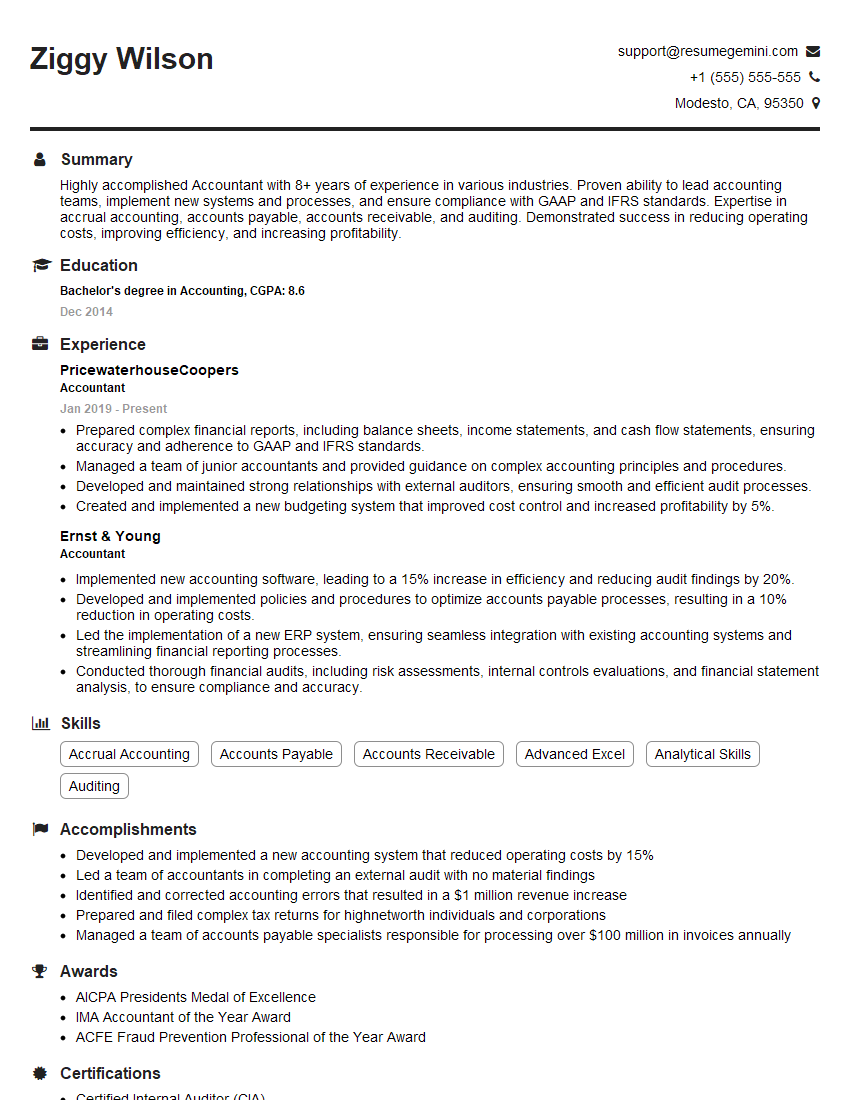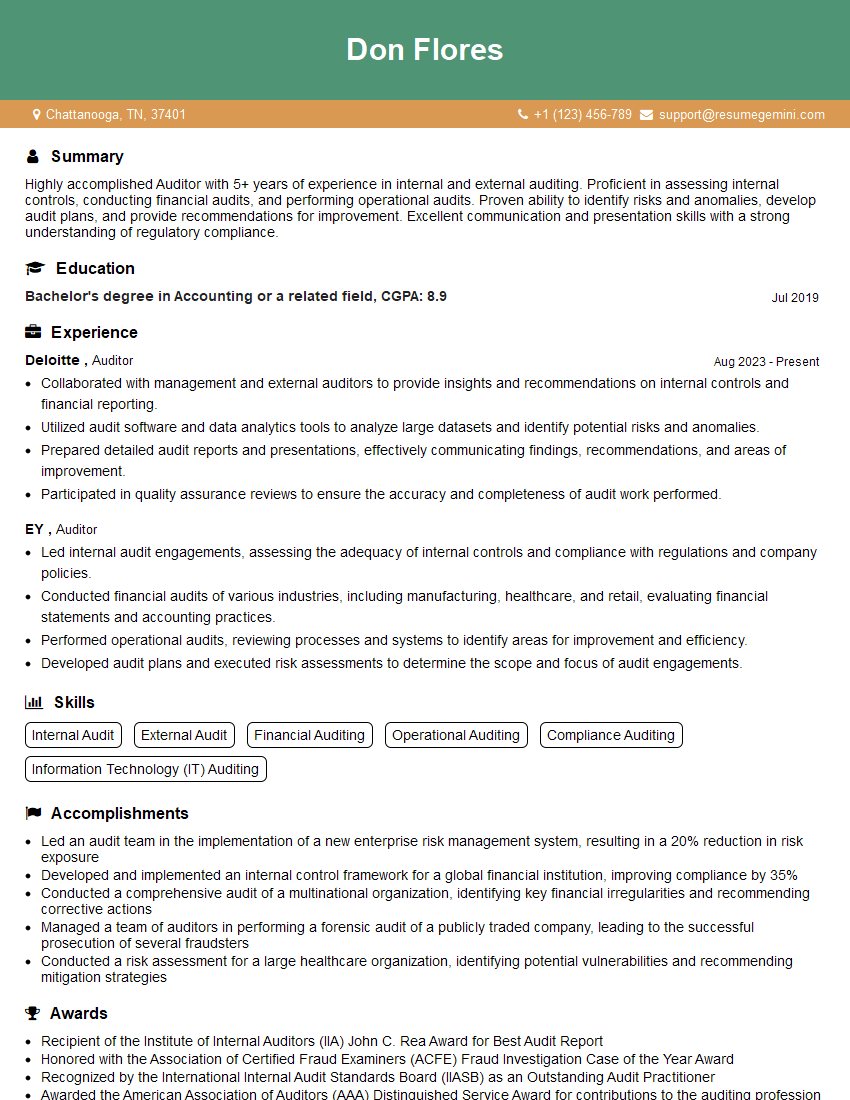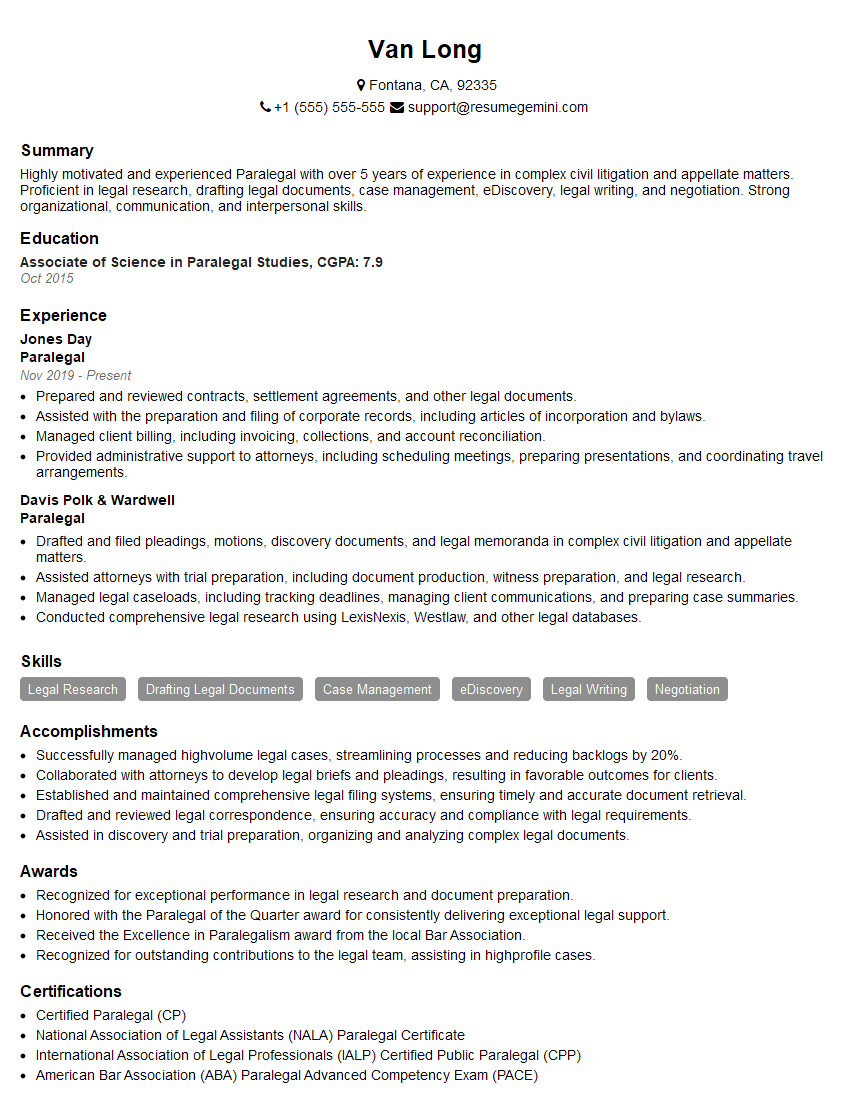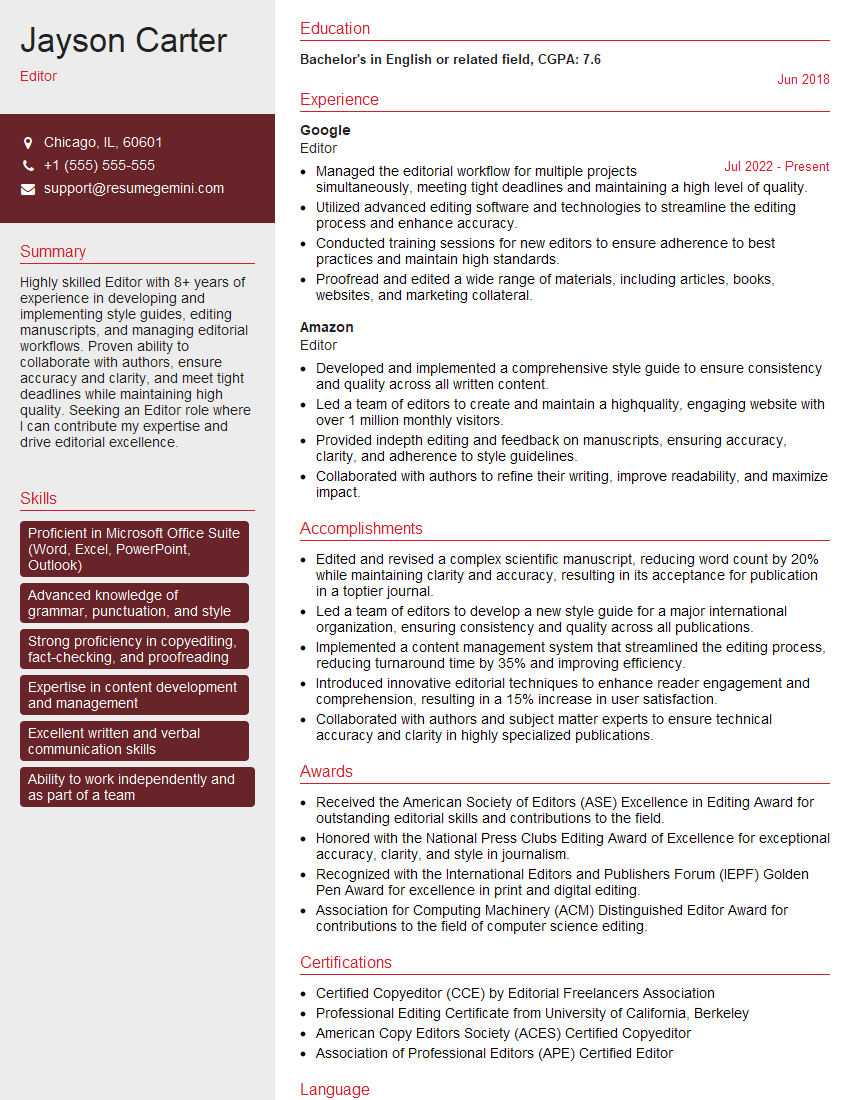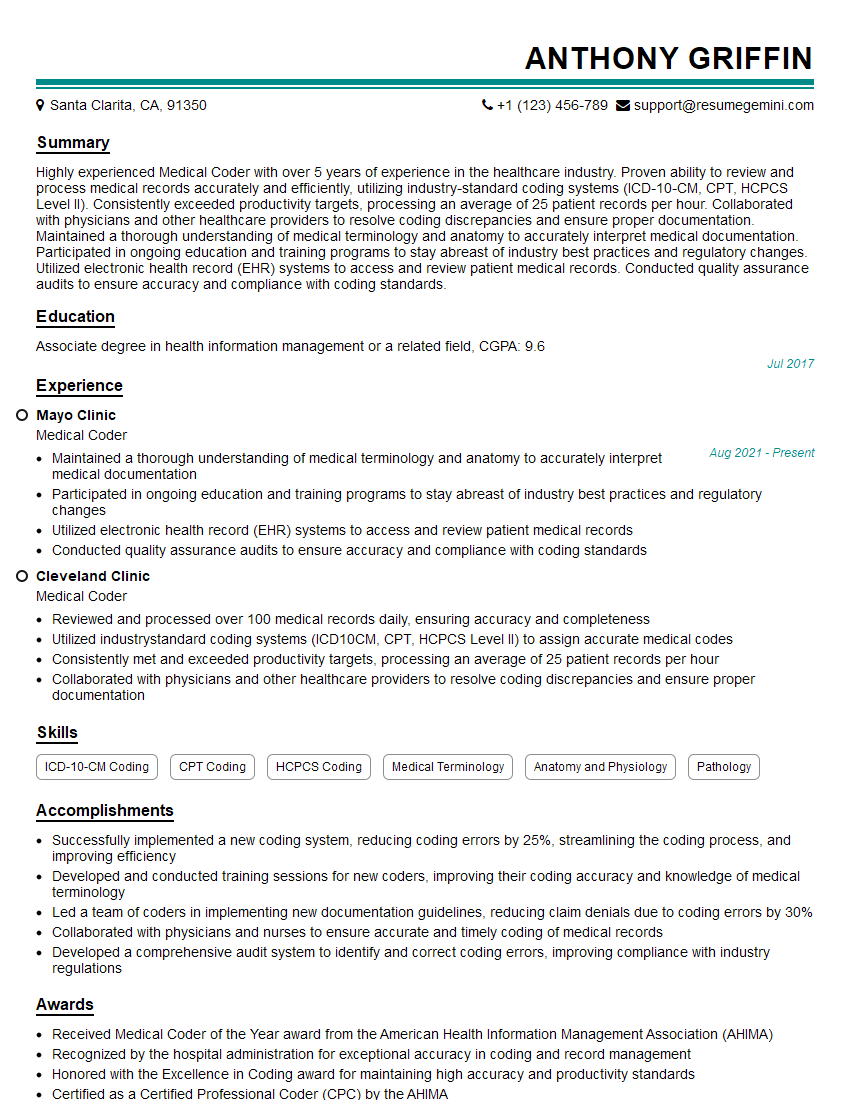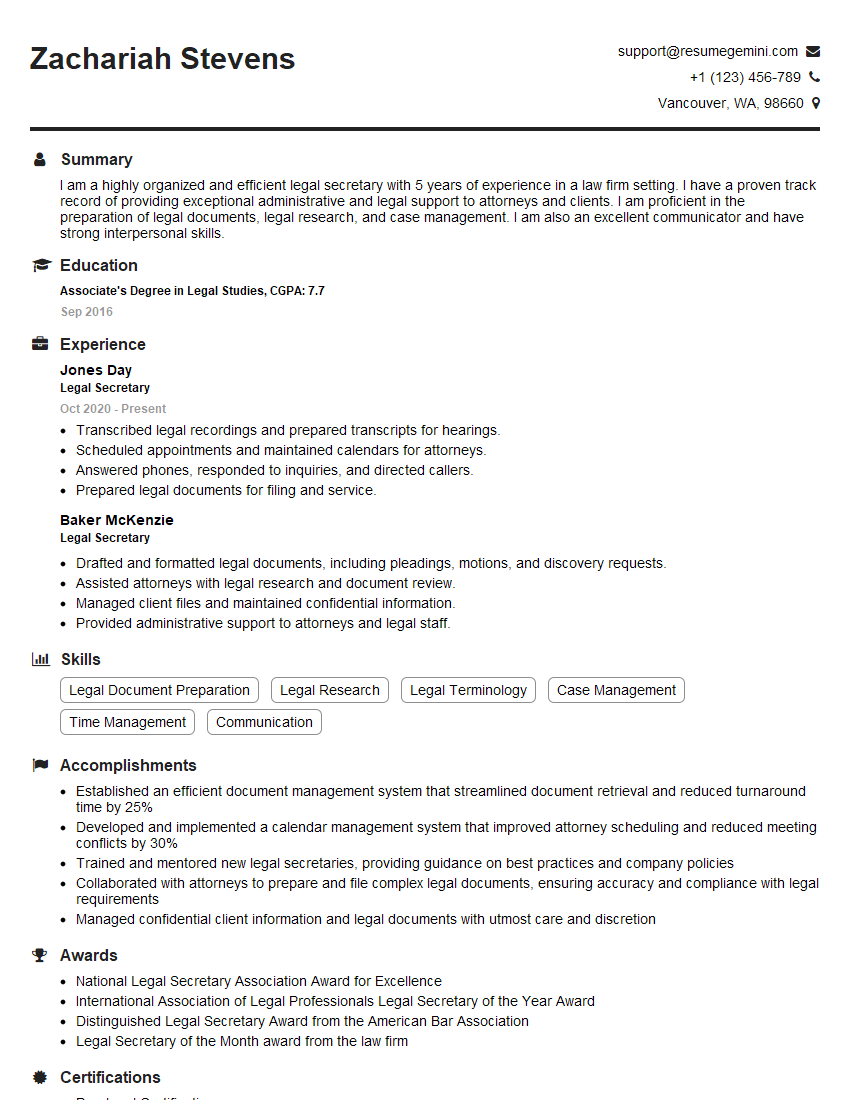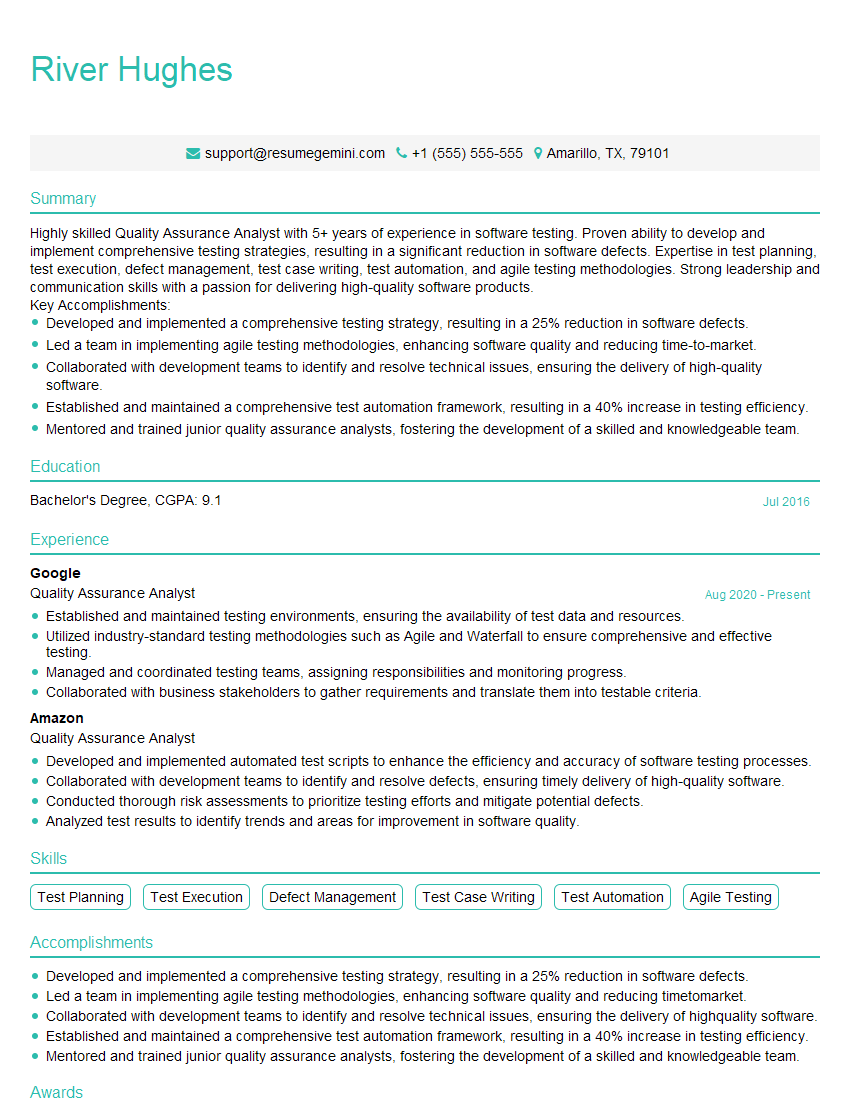Feeling uncertain about what to expect in your upcoming interview? We’ve got you covered! This blog highlights the most important Strong attention to detail and quality interview questions and provides actionable advice to help you stand out as the ideal candidate. Let’s pave the way for your success.
Questions Asked in Strong attention to detail and quality Interview
Q 1. Describe a time you noticed a small error that others missed. How did you handle it?
During a critical project involving the design of a marketing brochure, I noticed a subtle discrepancy in the font size used for a key headline across different sections. While the difference was only one point, it created a noticeable visual inconsistency that others had overlooked. My meticulous nature, combined with my use of a digital proofing tool, highlighted this error. I didn’t immediately point out the mistake, but instead created a detailed comparison document showcasing the variations, along with proposed solutions. This allowed for a collaborative discussion, ensuring everyone understood the importance of the correction and avoiding future similar oversights. The team was appreciative of the methodical way I presented the issue and the solution, appreciating the overall improvement to the design’s consistency and professionalism.
Q 2. How do you prioritize tasks when dealing with multiple deadlines and high attention-to-detail requirements?
Prioritizing tasks with multiple deadlines and high attention-to-detail requirements necessitates a structured approach. I use a combination of methods including Eisenhower Matrix (urgent/important), time blocking, and task decomposition. First, I categorize tasks by urgency and importance. Urgent and important tasks take priority. Then, I break down large, detail-intensive tasks into smaller, more manageable chunks. This allows me to focus intensely on one area without feeling overwhelmed. Time blocking schedules specific time slots for each task, ensuring I dedicate sufficient focused time to each and prevent task-switching. Regular review and adjustment of this schedule are key to handling shifting priorities and deadlines effectively.
Q 3. Explain your process for reviewing your own work for errors and inconsistencies.
My self-review process is multi-phased and designed to catch both big-picture and granular errors. Firstly, I take a break from my work to gain some distance. Then, I review for logical inconsistencies, checking that facts and figures align and that the overall narrative flows smoothly. Next, I conduct a meticulous line-by-line check, paying close attention to spelling, grammar, punctuation, and formatting. Lastly, I read my work aloud to identify awkward phrasing or missed errors that the eyes might have overlooked. This multi-faceted approach ensures a thorough review process.
Q 4. Describe your approach to proofreading and editing documents for accuracy and clarity.
My approach to proofreading and editing is systematic. I start by reading the document for overall clarity and comprehension. Then, I move to a line-by-line review. I use a checklist to ensure consistent application of style guidelines, including formatting, punctuation, and capitalization. I check for factual accuracy, consistency in terminology, and clarity of expression. Finally, I perform a final read-through to check for any remaining errors. I find that using a different medium – reading aloud or printing a copy – can often catch errors that are missed on screen.
Q 5. How do you ensure accuracy in data entry or data analysis tasks?
Accuracy in data entry and analysis is paramount. My strategy involves several steps: double-checking data entry against source documents, using data validation tools to identify inconsistencies, utilizing checksums or other data integrity checks where possible, and regularly reviewing my work for patterns or outliers that might indicate errors. In addition, I always verify data sources and ensure that they are credible and reliable. For complex data sets, I may use automated cross-checks and statistical analyses to identify inconsistencies and potential inaccuracies. The use of data validation tools is indispensable, especially when dealing with large datasets. For example, using Excel’s data validation feature to enforce specific data types or ranges is essential.
Q 6. Have you ever had to correct a significant error? Explain the process and outcome.
Maintaining focus on detail-oriented tasks requires conscious effort. I employ techniques like the Pomodoro Technique (working in focused bursts with short breaks), minimizing distractions (turning off notifications, using noise-canceling headphones), creating a dedicated workspace, and regularly taking short breaks to avoid mental fatigue. I also prioritize tasks and handle the most demanding ones when my energy levels are highest. Additionally, ensuring adequate sleep, regular exercise, and a healthy diet are crucial to maintaining optimal cognitive function and focus.
Q 7. What strategies do you employ to maintain focus and concentration on detail-oriented tasks?
In a previous role, I discovered a significant error in a financial report that had already been distributed to stakeholders. The error involved a miscalculation that resulted in a substantial discrepancy in projected revenue. I immediately notified my supervisor, outlining the error and detailing the steps I’d taken to verify the mistake. We developed a detailed correction plan, including a revised report and a communication strategy to inform stakeholders. We addressed the error swiftly and transparently, acknowledging the mistake and explaining the corrective actions. The outcome was positive; our honesty and prompt response to the issue maintained stakeholder trust and prevented further complications. The experience reinforced the importance of thorough verification processes and clear communication in high-stakes situations.
Q 8. How do you handle pressure when working on tasks requiring a high degree of accuracy?
When faced with high-pressure situations demanding accuracy, my approach is systematic and proactive. I begin by breaking down the task into smaller, manageable components. This helps prevent feeling overwhelmed and allows for focused attention on each detail. I prioritize tasks based on urgency and criticality, ensuring that the most crucial aspects receive the necessary time and concentration. I also utilize time management techniques like the Pomodoro Technique to maintain focus and prevent burnout. Regular breaks help me maintain mental clarity and prevent errors caused by fatigue. Finally, I employ self-checking mechanisms – a form of self-quality control – throughout the process, ensuring that each step aligns with the required standards before proceeding to the next. This methodical approach significantly reduces stress and improves the likelihood of a flawless outcome.
Q 9. Give an example of a time you identified a quality issue in a product or process. What did you do?
During a recent project involving the development of a data analysis tool, I noticed inconsistencies in the output reports. While the initial results appeared accurate at a glance, closer inspection revealed discrepancies in data aggregation for specific subsets. I immediately documented these inconsistencies, including screenshots and detailed descriptions of the affected data points. I then systematically investigated the root cause, analyzing the code logic and input data. I discovered a flaw in a nested loop within a critical function, which was causing incorrect calculations under certain conditions. I presented my findings, along with the proposed solutions (including updated code and revised testing procedures), to the team lead. This led to a revision of the code and the implementation of enhanced unit tests, effectively eliminating the issue and improving the overall quality and reliability of the tool.
Q 10. How do you balance speed and accuracy in your work?
Balancing speed and accuracy is a constant juggling act. It’s not about compromising one for the other, but about finding the optimal equilibrium. I start by understanding the criticality of the task – is speed paramount, or is absolute accuracy non-negotiable? My strategy involves using efficient workflows and tools to streamline the process. This includes leveraging automation wherever possible and refining my methods to enhance productivity. But efficiency doesn’t mean rushing; it means working smarter, not harder. I also prioritize quality control checks at critical stages, ensuring that accuracy isn’t sacrificed for speed. Finally, I build in buffer time for unexpected issues or revisions, allowing me to address potential problems without jeopardizing deadlines. This careful planning ensures that I consistently deliver accurate results within reasonable timeframes.
Q 11. Describe your experience using quality control checklists or other quality assurance tools.
I have extensive experience utilizing various quality control checklists and assurance tools. In previous roles, I’ve used checklists for everything from software testing (ensuring all functionalities are tested and documented) to document review (checking for consistency, grammar, and style). I’m also proficient with software tools like Jira for bug tracking and resolution, and have experience with version control systems (e.g., Git) that ensure code quality and track changes. These tools provide a structured approach to quality control, preventing oversight and ensuring consistency. The key is to adapt the tools and checklists to the specific needs of the task, making them as practical and efficient as possible. For example, a simplified checklist can be effective for simple repetitive tasks while a more complex, structured one might be necessary for complex projects.
Q 12. How do you approach a task when you’re unsure of the correct procedure or standard?
When encountering uncertainty about a procedure or standard, my first step is to consult available resources. This includes reviewing documentation, company guidelines, or established best practices. If the information isn’t readily accessible, I proactively seek clarification from colleagues or supervisors with relevant expertise. I meticulously document my questions and the steps I’ve taken to find a solution. This not only ensures clarity for myself but also provides valuable context if further assistance is required. I never guess or assume; instead, I prioritize verifying the correct approach before proceeding. This diligent approach prevents errors and ensures that my work aligns with established standards and procedures.
Q 13. How do you stay organized and manage your time effectively to prevent overlooking details?
Effective time management and organization are crucial for preventing oversight. I utilize a combination of techniques to maintain focus and avoid missing details. This includes creating detailed task lists, prioritizing items based on urgency and importance, and setting realistic deadlines. I often use project management software to track progress, manage dependencies, and allocate time effectively. I also segment my workday into focused blocks, dedicating specific times to specific tasks to enhance concentration. Furthermore, I regularly review my progress and adjust my schedule as needed. This proactive approach, combined with a well-organized workspace, minimizes distractions and ensures that no detail is overlooked.
Q 14. How do you communicate potential quality issues to your team or supervisor?
Communicating potential quality issues is critical for ensuring timely resolution and preventing further problems. My approach involves preparing a concise, well-structured report detailing the issue. This report includes specifics like the location of the problem, the observed deviation from expected standards, any potential impacts, and supporting evidence such as screenshots, data logs, or test results. I ensure the report is clear, factual, and avoids emotional language. I then communicate the issue through the appropriate channels, whether it’s a direct conversation with a team member, an email to a supervisor, or a formal bug report using a project management tool. I follow up on my communication to ensure the issue is addressed and resolved promptly, and I document the resolution process for future reference.
Q 15. What are some common pitfalls to avoid when striving for high accuracy?
Striving for high accuracy is commendable, but it’s crucial to avoid common pitfalls. One significant issue is rushing the process. Cutting corners to meet deadlines often leads to errors. Another pitfall is a lack of defined standards. Without clear guidelines and metrics for accuracy, your efforts may be subjective and inconsistent. Overlooking details due to fatigue or burnout is another frequent problem. Finally, failing to utilize appropriate tools and technologies can hinder your ability to achieve and maintain high accuracy.
- Example: Imagine preparing a financial report. Rushing through the calculations could lead to incorrect figures, impacting decision-making. Having clear guidelines about acceptable error margins beforehand prevents this.
- Example: In software development, neglecting to perform thorough testing before release can lead to bugs and compromised functionality, highlighting the need for well-defined testing protocols.
Career Expert Tips:
- Ace those interviews! Prepare effectively by reviewing the Top 50 Most Common Interview Questions on ResumeGemini.
- Navigate your job search with confidence! Explore a wide range of Career Tips on ResumeGemini. Learn about common challenges and recommendations to overcome them.
- Craft the perfect resume! Master the Art of Resume Writing with ResumeGemini’s guide. Showcase your unique qualifications and achievements effectively.
- Don’t miss out on holiday savings! Build your dream resume with ResumeGemini’s ATS optimized templates.
Q 16. Describe a situation where your attention to detail prevented a problem.
During a project involving the development of a medical device, I was responsible for reviewing the technical specifications. I noticed a discrepancy between the stated power requirements and the actual capacity of the battery component. The initial design overlooked this mismatch, potentially resulting in premature power failure during critical use. By catching this detail, I prevented a potentially life-threatening malfunction and initiated a design revision that ensured the device’s reliable operation.
Q 17. How do you adapt your approach to detail-oriented tasks depending on the context or complexity?
My approach to detail-oriented tasks adapts based on context and complexity. For simpler tasks, I use checklists and standardized procedures to ensure consistency and avoid oversight. For complex projects, I break them down into smaller, manageable components. This allows for focused attention and more thorough review at each stage. I also employ different verification methods. For example, a simple data entry task might only need a quick double-check, while a complex analysis might require peer review or independent validation.
- Example: Proofreading a short email demands a quick scan; proofreading a lengthy legal document requires a more methodical approach with multiple passes, focusing on grammar, spelling, punctuation, and factual accuracy.
Q 18. Explain how you ensure the accuracy of data you collect and analyze.
Ensuring data accuracy is paramount. I begin by using validated data sources whenever possible. This reduces the risk of inherent inaccuracies. I also implement data validation checks at each stage of the process, including input, processing, and output. This might involve using automated checks within spreadsheets or programming scripts to flag inconsistencies or anomalies. Data visualization techniques can reveal patterns or outliers that might indicate errors. Finally, I always document my data sources and methods meticulously, allowing for traceability and verification.
- Example: When analyzing sales data, I verify the data source’s reliability and check for inconsistencies like negative sales figures. I would also cross-reference this data with other relevant data sets (like customer demographics) to look for anomalies that could point to errors in the sales data.
Q 19. How do you handle conflicting priorities when attention to detail is crucial in multiple areas?
Conflicting priorities requiring attention to detail necessitate prioritization and effective time management. I use a prioritization matrix, assessing urgency and importance, to identify the most critical tasks. Then, I break down each task into smaller, manageable steps. This allows me to focus my attention to detail effectively on each section without feeling overwhelmed. Communication is key. I clearly communicate potential delays or trade-offs to stakeholders, fostering transparency and collaboration.
- Example: If I’m working on a complex report and simultaneously need to review a critical contract, I might dedicate specific time blocks to each, utilizing the Pomodoro Technique to maintain focus and avoid burnout.
Q 20. How do you use technology to improve your attention to detail and accuracy?
Technology plays a significant role in enhancing accuracy and attention to detail. I use software tools for data validation and cross-referencing, eliminating manual error possibilities. Version control systems help to track changes and ensure that revisions are easily reviewed. Spreadsheet software with features like data validation and error-checking aids in minimizing errors. Automated proofreading tools assist in identifying grammar and spelling errors. Ultimately, leveraging the right technology significantly streamlines the process and minimizes human error.
Q 21. What methods do you use to verify the accuracy of your work before submitting it?
My verification methods vary based on the task’s nature. For data analysis, I cross-check results using multiple methods and review statistical significance. For written documents, I use multiple proofreading passes, employing spell-checkers, grammar tools, and peer review. For code, I use automated testing and debugging tools along with manual testing and walkthroughs. In all cases, I maintain a detailed audit trail for traceability. This ensures that any error can be readily identified and corrected.
- Example: Before submitting a financial report, I’ll not only check the calculations independently but also compare them against previous periods’ data and relevant industry benchmarks to identify any unusual patterns.
Q 22. How do you proactively identify potential errors or inconsistencies in your work?
Proactive error identification is crucial for delivering high-quality work. My approach involves a multi-layered strategy focusing on prevention and detection. Before starting any task, I meticulously review requirements and specifications, clarifying any ambiguities upfront to minimize misunderstandings. During the execution phase, I employ techniques like checklists, self-reviews, and peer reviews to catch errors early. Think of it like building a house – you wouldn’t skip inspections! A checklist ensures all critical steps are completed, while self-reviews offer a fresh perspective to spot inconsistencies I might have missed during initial creation. Peer reviews provide an external viewpoint, catching errors I might be blind to due to familiarity with the work.
- Checklists: I create detailed checklists tailored to the specific task, ensuring all aspects are covered.
- Self-reviews: I take a break after completing a task and then review my work with a fresh perspective, simulating the eyes of a client or end-user.
- Peer reviews: I actively seek feedback from colleagues, especially those with different skill sets or perspectives, to identify blind spots.
For example, while developing a report, I’d use a checklist to verify data accuracy, correct formatting, and consistent referencing. A self-review would help me identify any unclear phrasing or inconsistencies in tone. A peer review could highlight issues I missed in the visual presentation or data analysis.
Q 23. Describe a time you had to explain a complex process with great attention to detail.
In a previous role, I had to explain a complex database migration process to a non-technical team. This involved breaking down a technically dense process into easily digestible components. I used a combination of visual aids, simple analogies, and step-by-step explanations. Imagine explaining the intricacies of the human heart to a five-year-old – you wouldn’t use medical jargon! I started with a high-level overview, presenting the ‘why’ behind the migration and its overall impact. Then, I broke down the process into distinct phases, using a flowchart to illustrate the sequence of events. I supplemented this with plain language descriptions of each stage, drawing parallels to everyday life processes. For instance, I compared data migration to moving furniture from one house to another, each step representing packing, transportation, unpacking, and verification. This approach ensured everyone understood not only what was happening but also why it was necessary and how each step contributed to the overall success of the project.
Q 24. How do you stay updated on industry best practices related to quality control?
Staying updated on industry best practices for quality control is an ongoing commitment. I actively participate in online communities, attend webinars and conferences, and regularly review industry publications and journals. Think of it as continuous professional development – just like doctors stay updated on medical advancements. I subscribe to relevant newsletters and podcasts to receive updates on emerging trends and technologies in quality management. I also actively participate in professional organizations focused on quality control and actively seek out mentorship from experienced professionals in the field. These combined activities allow me to stay current on evolving quality control techniques, tools, and methodologies, and then apply these learnings to improve my own processes.
Q 25. How do you ensure consistency in your work across multiple projects or tasks?
Maintaining consistency across multiple projects requires a structured approach. I utilize templates, style guides, and standardized processes. Templates offer pre-defined formats ensuring consistency in deliverables, while style guides define standards for writing, formatting, and visual elements. Standardized processes ensure uniformity in task execution across various projects. This proactive approach avoids inconsistencies from project to project. Imagine a factory assembly line – every car produced follows the same standardized process, resulting in consistency. Similarly, my standardized processes guarantee uniform high quality across all projects. I also use version control systems (like Git) for collaborative projects and documentation, enabling me to track changes, maintain history and ensure everyone is on the same page.
Q 26. Describe a time you had to revise or improve a process to enhance quality or accuracy.
In a previous project involving data analysis, we initially used a manual data cleaning process which was time-consuming and prone to errors. After noticing repeated issues, I proposed automating the data cleaning process using Python scripting. This involved creating scripts to handle data validation, standardization, and anomaly detection. The implementation of automated data cleaning significantly reduced processing time and eliminated manual errors, resulting in improved accuracy and increased efficiency. This automated system also provided better auditability, letting us track all data transformations. The shift from a manual to an automated system perfectly illustrates a proactive approach to process improvement in the pursuit of better quality and accuracy.
Q 27. How do you handle feedback that points out errors or omissions in your work?
Feedback, especially concerning errors, is invaluable. I welcome constructive criticism as an opportunity for growth. When receiving feedback highlighting errors or omissions, I approach it systematically. First, I carefully review the feedback to fully understand the concerns. Then, I investigate the root cause of the error, which might involve reviewing my work process or the underlying data. I document the error and the corrective actions taken. Finally, I implement the necessary corrections and use this as a learning opportunity to improve my future work, possibly updating my checklist or process to prevent similar mistakes. This process ensures that errors are not repeated and that I learn from my mistakes, transforming them into opportunities for continuous improvement.
Q 28. What steps do you take to ensure that your work meets or exceeds quality standards?
Meeting and exceeding quality standards is a core principle in my work. My approach is multifaceted, involving rigorous self-checking, thorough testing, and adherence to best practices. Before submitting any work, I conduct a comprehensive self-review, using checklists and style guides to ensure adherence to standards. I then perform rigorous testing to identify potential issues or inconsistencies, simulating real-world scenarios to assess functionality and usability. Finally, I seek external feedback from colleagues or mentors to gain an unbiased perspective. This layered approach ensures that my work consistently meets or exceeds the expectations for quality, accuracy, and completeness. Think of it as a quality assurance funnel – each stage filters out potential issues, ensuring only high-quality work makes it through to the end.
Key Topics to Learn for Strong Attention to Detail and Quality Interviews
- Understanding the Concept: Define “attention to detail” and “quality” within the context of your chosen field. Consider how these translate into tangible actions and deliverables.
- Practical Application: Give examples from past experiences where you demonstrated exceptional attention to detail and how this led to positive outcomes. Quantify your achievements whenever possible.
- Error Detection and Prevention: Discuss strategies you employ to proactively identify and prevent errors. This might include checklists, peer reviews, or self-assessment techniques.
- Quality Control Processes: Explain your understanding of quality control methodologies and how you apply them in your work. Describe your role in ensuring the highest standards are met.
- Problem-Solving with Precision: Illustrate how your meticulous approach helps you effectively diagnose and solve complex problems. Highlight your ability to identify root causes and implement effective solutions.
- Adaptability and Continuous Improvement: Explain how you adapt your approach to maintain quality and attention to detail in diverse situations and how you actively seek ways to improve your processes.
- Teamwork and Collaboration: Discuss how you contribute to a team’s collective attention to detail and quality, ensuring consistent standards across projects.
Next Steps
Mastering attention to detail and quality is paramount for career advancement. Employers highly value individuals who consistently deliver high-quality work and minimize errors. A well-crafted resume is your first impression – make it count! Building an ATS-friendly resume significantly increases your chances of getting noticed by recruiters. ResumeGemini offers a trusted platform to create professional, impactful resumes tailored to highlight your skills and experience. We provide examples of resumes specifically demonstrating strong attention to detail and quality to help you craft your best application. Use ResumeGemini to unlock your full potential and land your dream job.
Explore more articles
Users Rating of Our Blogs
Share Your Experience
We value your feedback! Please rate our content and share your thoughts (optional).
What Readers Say About Our Blog
Hello,
We found issues with your domain’s email setup that may be sending your messages to spam or blocking them completely. InboxShield Mini shows you how to fix it in minutes — no tech skills required.
Scan your domain now for details: https://inboxshield-mini.com/
— Adam @ InboxShield Mini
Reply STOP to unsubscribe
Hi, are you owner of interviewgemini.com? What if I told you I could help you find extra time in your schedule, reconnect with leads you didn’t even realize you missed, and bring in more “I want to work with you” conversations, without increasing your ad spend or hiring a full-time employee?
All with a flexible, budget-friendly service that could easily pay for itself. Sounds good?
Would it be nice to jump on a quick 10-minute call so I can show you exactly how we make this work?
Best,
Hapei
Marketing Director
Hey, I know you’re the owner of interviewgemini.com. I’ll be quick.
Fundraising for your business is tough and time-consuming. We make it easier by guaranteeing two private investor meetings each month, for six months. No demos, no pitch events – just direct introductions to active investors matched to your startup.
If youR17;re raising, this could help you build real momentum. Want me to send more info?
Hi, I represent an SEO company that specialises in getting you AI citations and higher rankings on Google. I’d like to offer you a 100% free SEO audit for your website. Would you be interested?
Hi, I represent an SEO company that specialises in getting you AI citations and higher rankings on Google. I’d like to offer you a 100% free SEO audit for your website. Would you be interested?
good





